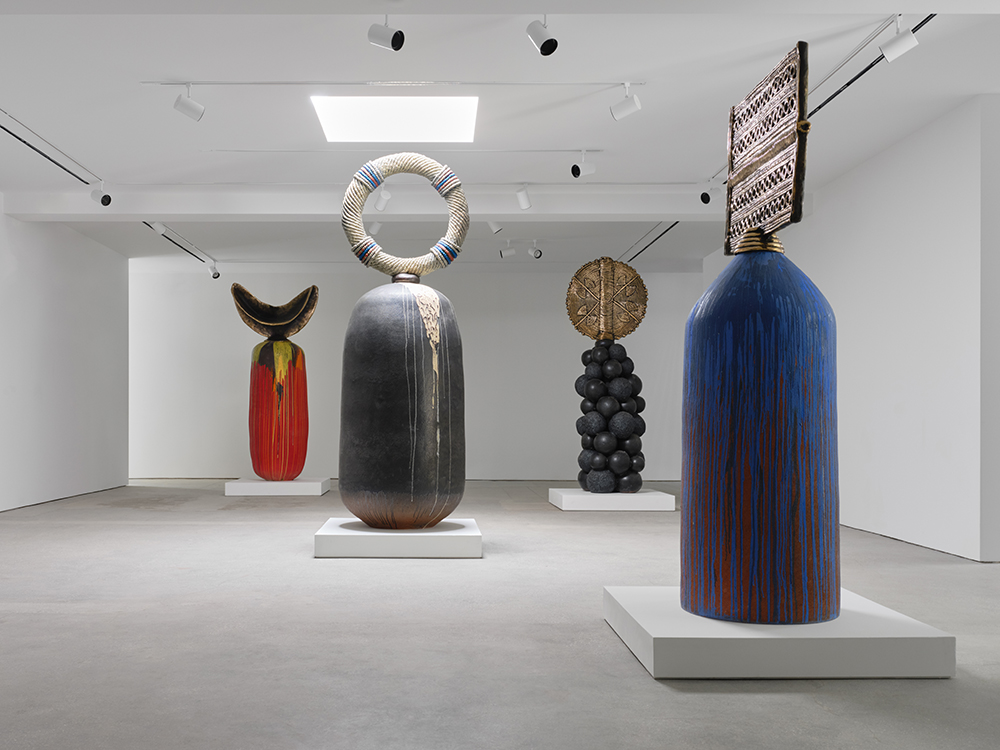Zizipho Poswa’s monumental ceramic and bronze sculptures hold court like an enclave of demigods. While not figurative per se, they are anthropomorphic in the way all ceramic vessels are: All are additionally crowned with towering, ornate objects that radiate ceremonial significance whether or not one is conversant in their Pan-African cultural references. However, the viewer who takes the time to learn these references is amply rewarded. Returning to the works with a fuller understanding of their matriarchal, ceremonial, artisanal characters, one finds their evocation of protective feminine forms even more powerful.
The objects-turned-crests that rest atop Poswa’s five freestanding sculptures are interpretations of objects from the realms of beauty, adornment and healing drawn from a cluster of African cultural traditions including the artist’s own—partly as a means of personal narrative, partly as an ode to the enduring and unparalleled skills of African craftspeople and finally as a reminder of the histories of sophisticated and thriving matriarchal societies across the wealthy Nubian kingdom. But rather than enlarged depictions, Poswa’s ceramic and metal pieces are the result of transformative actions and are shaped as much by contemporary sensibilities of theatricality and emotion as by treasured legacy.

Zizipho Poswa, Lobi, 2024. Courtesy of the artist and Southern Guild.
To accomplish this feat, the artist enlisted the support of legendary boundary-pushing ceramicist Tony Marsh and the Center for Contemporary Ceramics (CCC) at California State University, Long Beach, with the result that the final works were largely produced here in Los Angeles and informed by this community’s stature as an international crossroads for the medium. One example of Poswa’s nods to modernity within this discourse is the way pigments (bright blue, red and yellow tussling with inky black splatter) are applied to the ceramic “bodies” of the works. In an assertively modern way, these painterly moments read like Abstract Expressionism. In lieu of the anticipated pattern or illustration of an important scene, the energetic gestures are disruptive of tradition in a way that feels expansive rather than subversive.
This strategy is evident in Akan (all works 2024), in which a vessel cloaked in lapis-lazuli blue dripping into a gradient of terra cotta is crowned with an embossed bronze crest that evokes a traditional emblem of the Asante queen mother. In Fulani, the reference is to gold earrings traditionally worn by women in West Africa as symbols of social status or wealth—the bigger the better. Its body is an explosion of fiery red and yellow and has an unmissable resonance with mid-century abstraction. The bird-shaped comb form atop Cisakulo comes from what is now Mozambique, but its chic black-and-white, two-cavity body with its perfectly placed splash of pigment could have come straight from the runway. In each case, the elevated object/image that crowns these sculptures feels authentic and resonant. Their scale is at once operatic and temple-ready; and their meaning is also capacious—they are able to hold forms of personal significance and references to 20th-century art history alongside cultural inheritance and a dazzling vision of the future.


